First impressions are especially important in the hotel industry since the opinions a guest forms when they walk into a lobby for the first time are permanent. Hotel managers and owners know how vital a happy guest is to a hotel. While it may be tempting to slash prices in order to attract guests, there are other methods. Temporarily reducing prices may work in the short term, but building a good reputation will pay off for years. Today, social media has accelerated any positive or negative word of mouth a hotel may receive. A hotel should be careful to present itself in a professional matter, regardless of how casual the guests may behave while on vacation. Hotel staff should always be perceived as both competent and friendly. The hotel grounds, lobby and rooms should be inviting.
First impressions begin online
Most people now use the Internet to research and book hotel rooms from the comfort of home. Therefore, a guest’s impression of a hotel may be formed before they ever step foot on the property or speak with a single hotel employee. Search Engine Optimization, or SEO, should be flawlessly integrated into the text of the website. Clunky SEO phrases may help search engines find the hotel webpage, but also have the potential to turn off potential customers. The hotel website should be easy to navigate and include both a contact phone number and email address on each page. Photos of the guest rooms and grounds should be plentiful and, if possible, professionally done. A hotel website should be careful not to oversell its amenities or the hotel’s location. A guest expecting ocean views from their room will not be happy if they do not actually have ocean views. A hotel can build goodwill with their guests by being honest. Providing helpful information about nearby restaurants and popular activities is also a good way to build trust.
Social media, such as Facebook and Twitter, are other ways guests may connect with the hotel before they book a room. Any inquires should be quickly answered. Some companies have had luck attracting new clients by making their Facebook or Twitter feeds fun and humorous, yet still professional. Posting images, updates, and other news should be done no more than once a day, but at least three times each week.
Hotel grounds
Once a guest is on site, they should find lovely, manicured grounds, clearly marked parking and directional signs. The easier it is to navigate around the resort, the more a guest can focus on their stay. If the hotel and resort has been created with a tropical theme in mind, one of the biggest visual clues should be a unique roof. A thatch roof, for example, gives a hotel a fun alternative to a plain, boring roof. Palmex International, Inc. manufactures synthetic thatch roofing material that is durable, attractive and recyclable. Palmex roofing products have an estimated lifespan of fifty years. This far outlasts all other roofing materials. Installing Palmex thatch roofing saves the hotel money, not only because the product lasts so long, but also because the material is specially treated to help lower air conditioning costs.
Inside the lobby
A guest visiting a lobby for the first time should be easily able to find the front desk and ask for assistance. Fresh flowers placed around the lobby are attractive and welcoming. All surfaces should be kept clear and uncluttered. The walls should be repainted whenever needed to maintain a fresh look. Carpet or tile should be able to withstand heavy foot traffic without looking worn. Any rips, cracks or stains should be repaired as soon as possible. A lobby should be both inviting and relaxing, after all this is where the guests begin their vacation.
Guest rooms
It is reasonable to assume guests will spend at least ten hours out of each day in their hotel room. They may spend most of that time sleeping, but the layout and decor of the guest rooms is still important. Each room should be inspected regularly to ensure everything works the way it should. Guests will always remember poor lighting, showers with no water pressure or improperly functioning air conditioning units.


Recent Comments